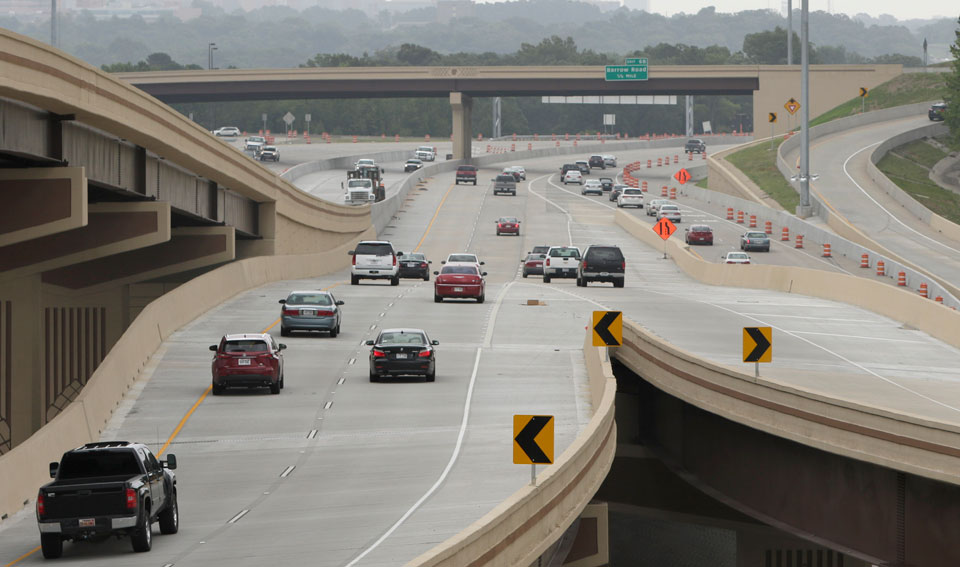
LITTLE ROCK, Ark.—Running east-west through the middle of the Little Rock, Ark., metro area, Interstate 630 divides Arkansas’ capital city from its top suburb in more ways than one.
Not only does the federally-funded freeway split Little Rock on the south from North Little Rock on the north, but it also splits the whiter, richer north side of the metro area, from the poorer, black and brown south side.
That segregation’s intentional. And that’s common, from Detroit’s Eight Mile Road to Chicago’s Dan Ryan Expressway to New York City’s Robert Moses building bridges low enough so that city buses, carrying blacks, couldn’t drive under them on the way to the Big Apple’s beaches.
And that’s what advocates of pumping billions of new federal dollars into U.S. highways, railroads, subways and airports want to prevent happening again.
Studies show that from Baltimore to Detroit, from Little Rock to Chicago, highways – and, before them, railroads – were deliberately sited by governments and built by either governments or companies to maintain or extend racial and class segregation. And there were unusual twists like Moses’ anti-bus bridges, too.
And while an airport site might be neutral racially, flight paths the planes follow nationwide in takeoffs or landings are another matter, speakers at a May 13 infrastructure symposium said. Guess who suffers the most plane noise from Chicago’s O’Hare Airport? Hint, unless you’re on the North Shore late on summer evenings, it’s not ultra-ritzy Kenilworth.
And federally funded expressways not only split the races, but often, especially after the advent of mass suburbanization following World War II, permitted “white flight” from central cities, studies show.
So Chicago’s monstrous Dan Ryan Expressway not only separates whites from blacks on the South Side, deliberately, but lets other whites drive out of the Loop at night to the south and southwest suburbs.
Former Obama-era Transportation Secretary Anthony Foxx, Little Rock Mayor Frank Scott and Teachers President Randi Weingarten don’t want to see a rerun of all that.
Weingarten, Foxx, who is also former Mayor of Charlotte, N.C., and Scott, a former Arkansas Transportation Director, discussed the problem at the first panel called during the May 13 kickoff of National Infrastructure Week.
That’s a lobbying effort by unions, businesses and state and local leaders nationwide to convince Congress to plow more money into repairing and replacing the nation’s crumbling roads, cracked bridges, creaky railroads, century-old water mains, aging airports and under-maintained subways.
Whether it will succeed or not depends on President Trump providing political cover to raise the federal gas tax for the first time in a quarter of a century.
But assuming success, that still leaves the looming problem of the use of infrastructure to divide the country, and particularly its metro areas, by race and class.
“I-630 is a barrier – a cement line between North Little Rock and Little Rock. And there was a lot of redlining, too,” said Scott, referring to housing policy, perpetrated by both the federal government and private developers, that locked people of color into ghettos, especially in the nation’s largest cities.
“It created a line between haves and have-nots.”
“We put up highways through places where people didn’t have the Voting Rights Act, so they didn’t have a voice,” Foxx elaborated.
But while Foxx, Scott, and Weingarten outlined and blasted past use of infrastructure to perpetuate racial and class divisions, finding solutions was another matter.
“The undercurrent needs to be more and better infrastructure for all,” said Foxx, who is now chief policy officer for the “gig economy” ride-share service Lyft – a firm whose drivers, many of them minorities, say keeps cutting their pay and changing their working conditions.
Weingarten offered another way: Get everyone, but especially the local community and its representatives, in on the ground floor when infrastructure projects are planned.
That was done in schools when AFT insisted on parent, teacher, principal and community participation in planning programs and meeting school infrastructure needs in her home, New York City. It wasn’t when Moses ran the city’s and state’s transportation show.
And all three said that in a time of increasing congestion on the nation’s roads, more money must be pumped into mass transit alternatives such as subways, bus purchases, dedicated busways, and light rail lines.
But again, they pointed out, just like the rail lines of the Gilded Age, those new lines can’t just exist to whisk suburbanites in and out. They need, the three said, to connect inner-city residents to outer suburban jobs. “There’ll be a need for cars, but also for mass transit,” Scott said.
Like free stuff? So do we. Here at People’s World, we believe strongly in the mission of keeping the labor and democratic movements informed so they are prepared for the struggle. But we need your help. While our content is free for readers (something we are proud of) it takes money — a lot of it — to produce and cover the stories you see in our pages. Only you, our readers and supporters, can keep us going. Only you can make sure we keep the news that matters free of paywalls and advertisements. If you enjoy reading People’s World and the stories we bring you, support our work by becoming a $5 monthly sustainer today.

MOST POPULAR TODAY


Communist Karol Cariola elected president of Chile’s legislature

Zionist organizations leading campaign to stop ceasefire resolutions in D.C. area

Afghanistan’s socialist years: The promising future killed off by U.S. imperialism

High Court essentially bans demonstrations, freedom of assembly in Deep South






Comments